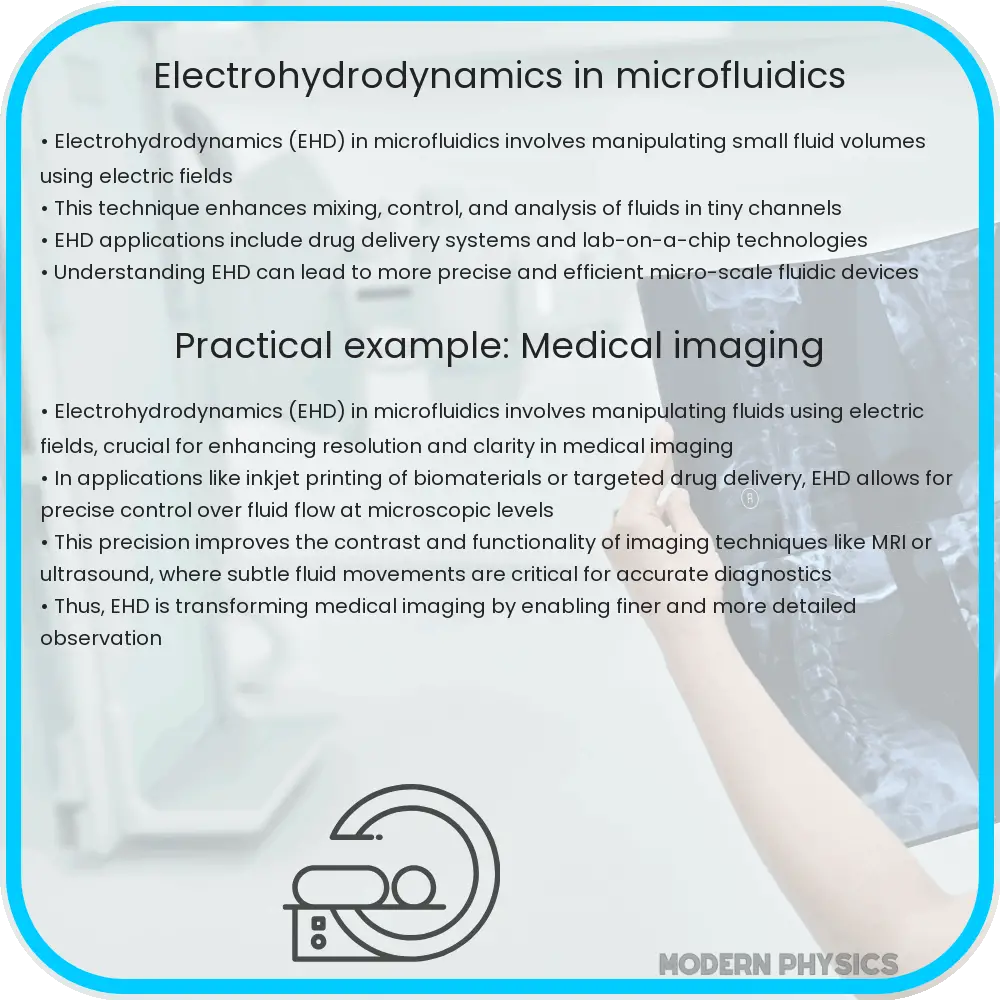Explore the principles, applications, and innovations of Electrohydrodynamics in Microfluidics, a key technology shaping future diagnostics and research.

Understanding Electrohydrodynamics in Microfluidics
Electrohydrodynamics (EHD) is a fascinating field of study that merges the principles of electricity and fluid dynamics. In the realm of microfluidics, EHD plays a pivotal role in manipulating fluid behavior on a microscale. This article delves into the core principles of EHD in microfluidics, its diverse applications, and the latest innovations shaping the future of this technology.
Principles of Electrohydrodynamics
At the heart of EHD lies the interaction between electric fields and fluid flow. In microfluidics, electric forces are used to control the movement and behavior of fluids in channels with dimensions of tens to hundreds of micrometers. The fundamental principle of EHD in microfluidics is the Coulomb force, which acts on charged particles within the fluid. This force can induce motion and instigate various fluidic phenomena such as electro-osmosis, electrophoresis, and dielectrophoresis.
Electro-osmosis involves the movement of a fluid relative to a stationary charged surface due to an applied electric field. In contrast, electrophoresis refers to the migration of charged particles in a fluid under the influence of an electric field. Dielectrophoresis involves the movement of neutral particles caused by polarization effects in a non-uniform electric field.
Applications of Electrohydrodynamics
The versatility of EHD in microfluidics has led to its application in various fields. One prominent area is medical diagnostics, where EHD techniques facilitate the manipulation of biological samples for analysis. This includes the handling of DNA, proteins, and cells for purposes like disease detection and genetic testing.
In the pharmaceutical industry, EHD is employed for drug delivery and development. Microfluidic devices can create uniform drug particles and capsules, enhancing the efficiency of drug delivery systems. Additionally, EHD is crucial in environmental monitoring, aiding in the detection of pollutants and hazardous substances in water and air samples.
Innovations in Electrohydrodynamics
Recent advancements in EHD have been groundbreaking. Innovations include the development of more efficient microfluidic chips, which allow for faster and more accurate analysis. There’s also a growing trend in integrating EHD microfluidic devices with other technologies, such as nanotechnology and biotechnology, to enhance their capabilities.
Furthermore, the rise of digital microfluidics, which employs electrostatic manipulation of droplets on a planar surface, has opened new avenues for high-throughput screening and point-of-care diagnostics. This integration of EHD with digital technology paves the way for more compact, faster, and more versatile microfluidic devices.
Another innovative aspect is the use of EHD in creating artificial organs and tissues. By precisely controlling the movement and assembly of cells, researchers can fabricate complex biological structures, which has significant implications for tissue engineering and regenerative medicine.
Future Prospects of Electrohydrodynamics in Microfluidics
The potential of EHD in microfluidics extends far beyond current applications, promising revolutionary changes in numerous fields. One exciting prospect is in personalized medicine, where EHD techniques could enable the development of tailored therapies based on an individual’s unique biological profile. This personalized approach could lead to more effective treatments with fewer side effects.
Another area of potential is in the field of synthetic biology. EHD can be instrumental in constructing synthetic biological systems, offering a new pathway to understand and manipulate biological processes. This could lead to the creation of synthetic cells or organisms with specific desired functionalities, such as biofuel production or environmental remediation.
In the realm of fundamental research, EHD microfluidics is becoming an essential tool for studying the behavior of cells and microorganisms under various physical and chemical conditions. This could provide deeper insights into cellular mechanisms, potentially leading to breakthroughs in understanding diseases and developing new therapeutic strategies.
Challenges and Limitations
Despite its promising future, EHD in microfluidics faces challenges. The miniaturization of devices often leads to issues with heat dissipation and fluidic resistance, which can affect the efficiency and accuracy of EHD processes. Additionally, the integration of EHD devices with other systems, such as electronic sensors, requires sophisticated design and manufacturing techniques.
Another challenge lies in the standardization and scalability of EHD microfluidic devices. For widespread adoption, especially in clinical settings, these devices need to be produced consistently and cost-effectively on a larger scale. Ensuring reliability and reproducibility in different environments also remains a significant hurdle.
Conclusion
Electrohydrodynamics in microfluidics represents a convergence of physics, engineering, and biology, offering immense possibilities for innovation and discovery. Its applications in medical diagnostics, drug development, environmental monitoring, and beyond, demonstrate its versatility and potential for significant societal impact. As the technology continues to evolve, overcoming existing challenges, it is poised to play a crucial role in shaping the future of healthcare, research, and environmental sustainability. The ongoing exploration and refinement of EHD in microfluidics will undoubtedly lead to more groundbreaking advancements, making it a field ripe with opportunities for researchers, engineers, and entrepreneurs alike.
